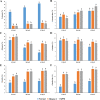Expression profile of protein fractions in the developing kernel of normal, Opaque-2 and quality protein maize
- PMID: 33510248
- PMCID: PMC7844038
- DOI: 10.1038/s41598-021-81906-0
Expression profile of protein fractions in the developing kernel of normal, Opaque-2 and quality protein maize
Abstract
Maize protein quality is determined by the composition of its endosperm proteins, which are classified as nutritionally poor zeins (prolamin and prolamin-like) and nutritionally rich non-zeins (albumin, globulin, glutelin-like, and glutelin). Protein quality is considerably higher in opaque-2 mutants due to increased content of non-zeins over zeins. However, the opaque-2 endosperm is soft, which leads to poor agronomic performance and post-harvest infestation. Endosperm modification of opaque-2 had led to the development of Quality Protein Maize (QPM), which has higher protein quality along with hard kernel endosperm. The present study was planned to analyze the expression dynamics of different protein fractions in the endospem of developing maize kernel in normal, opaque-2 and QPM in response to the introgression of endosperm modifiers. Results revealed that albumin and globulin content decreases, whereas, prolamin, prolamin-like, glutelin-like, and glutelin content increases with kernel maturity. It has been observed that opaque-2 mutation affects protein expression at initial stages, whereas, the effect of endosperm modifiers was observed at the intermediate and later stages of kernel development. It has also been noted that prolamin, glutelin, and glutelin-like fractions can be used as quick markers for quality assessment for differentiating QPM varieties, even at the immature stage of kernel development. Overall, the present study implicates the role of different protein fractions in developing and utilizing nutritionally improved maize varieties.
Conflict of interest statement
The authors declare no competing interests.
Figures



References
-
- Martinez EL, Fernandez FJB. Economics of production, marketing and utilization in corn. In: Serna-Saldivar SO, editor. Chemistry and Technology. Amsterdam: Elsevier; 2018. pp. 87–106.
-
- Shah TR, Parsad K, Kumar P. Maize-A potential source of human nutrition and Maize-A potential source of human nutrition and health. Cogent Food Agric. 2016;2:1–9. doi: 10.1080/23311932.2016.1166995. - DOI
-
- Bressani R. Protein quality of high lysine maize for humans. Cer. Food Wor. 1991;36:806–811.
-
- Ranum P, Pena-Rosas JP, Garcia-Casal MN. Global maize production, utilization, and consumption. Ann. N. Y. Acad. Sci. 2014;105:1312–1337. - PubMed
Publication types
MeSH terms
Substances
LinkOut - more resources
Full Text Sources
Other Literature Sources

